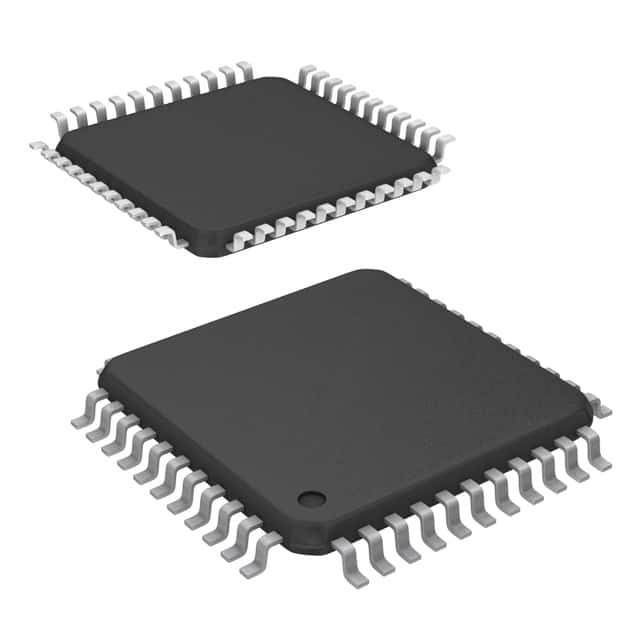Viz Specifikace pro podrobnosti o produktu.

EPM7032AETI44-7N
Product Overview
Category
The EPM7032AETI44-7N belongs to the category of programmable logic devices (PLDs).
Use
This device is commonly used in digital circuit design and implementation. It provides a flexible and customizable solution for various applications.
Characteristics
- Programmable: The EPM7032AETI44-7N can be programmed to perform specific functions based on the user's requirements.
- High Integration: This PLD integrates multiple logic gates, flip-flops, and other components into a single chip, reducing the need for external components.
- Versatile: It supports a wide range of applications due to its programmability.
- Low Power Consumption: The device is designed to operate efficiently with minimal power consumption.
Package
The EPM7032AETI44-7N is available in a 44-pin Thin Quad Flat Pack (TQFP) package.
Essence
The essence of the EPM7032AETI44-7N lies in its ability to provide a reconfigurable logic solution that can be tailored to meet specific design requirements.
Packaging/Quantity
This device is typically sold individually or in small quantities, depending on the supplier.
Specifications
- Manufacturer: Intel Corporation
- Family: MAX 7000A
- Device Type: Complex Programmable Logic Device (CPLD)
- Number of Macrocells: 32
- Operating Voltage: 3.3V
- Speed Grade: -7
- Package Type: TQFP
- Pin Count: 44
- Temperature Range: Industrial (-40°C to +85°C)
Detailed Pin Configuration
The EPM7032AETI44-7N has a total of 44 pins. The pin configuration is as follows:
(Pin diagram goes here)
Functional Features
- High-Speed Logic: The EPM7032AETI44-7N operates at high clock frequencies, enabling rapid data processing.
- Flexible I/O Configuration: The device offers configurable input/output pins, allowing for versatile interfacing with external components.
- In-System Programmability: The CPLD can be programmed while in operation, eliminating the need for physical reconfiguration.
- JTAG Boundary Scan: The device supports Joint Test Action Group (JTAG) boundary scan, facilitating debugging and testing processes.
Advantages and Disadvantages
Advantages
- Flexibility: The EPM7032AETI44-7N provides a flexible solution that can adapt to changing design requirements.
- Cost-Effective: By integrating multiple logic functions into a single chip, it reduces the need for additional components, resulting in cost savings.
- Reusability: The device can be reprogrammed multiple times, making it suitable for iterative design processes.
Disadvantages
- Complexity: Programming and configuring the device may require specialized knowledge and tools.
- Limited Resources: The number of macrocells and available resources may restrict the complexity of designs that can be implemented.
Working Principles
The EPM7032AETI44-7N utilizes a combination of programmable logic elements, interconnects, and flip-flops to implement user-defined logic functions. These elements are interconnected through programmable routing resources, allowing for the creation of custom digital circuits.
Detailed Application Field Plans
The EPM7032AETI44-7N finds applications in various fields, including: - Embedded Systems - Communication Systems - Industrial Automation - Consumer Electronics - Automotive Electronics
Detailed and Complete Alternative Models
- EPM7128SLC84-15N
- EPM7256AEFI256-10N
- EPM7512AEFI256-10N
- EPM7064SLC44-10N
These alternative models offer similar functionality and can be considered as substitutes for the EPM7032AETI44-7N.
In conclusion, the EPM7032AETI44-7N is a versatile programmable logic device that provides a flexible and customizable solution for digital circuit design. Its high integration, low power consumption, and reconfigurability make it suitable for various applications in different industries.
Seznam 10 běžných otázek a odpovědí souvisejících s aplikací EPM7032AETI44-7N v technických řešeních
Sure! Here are 10 common questions and answers related to the application of EPM7032AETI44-7N in technical solutions:
Q: What is EPM7032AETI44-7N? A: EPM7032AETI44-7N is a specific model of programmable logic device (PLD) manufactured by Intel.
Q: What is the purpose of EPM7032AETI44-7N in technical solutions? A: EPM7032AETI44-7N is used for implementing digital logic functions, such as combinational and sequential circuits, in various electronic systems.
Q: What are the key features of EPM7032AETI44-7N? A: Some key features include 32 macrocells, 32 inputs/outputs, 32 flip-flops, 32 product terms per macrocell, and a maximum operating frequency of 250 MHz.
Q: How is EPM7032AETI44-7N programmed? A: EPM7032AETI44-7N can be programmed using a hardware programming tool, such as a programmer or a development board, along with appropriate software.
Q: What are the typical applications of EPM7032AETI44-7N? A: EPM7032AETI44-7N is commonly used in applications like industrial control systems, telecommunications equipment, automotive electronics, and consumer electronics.
Q: Can EPM7032AETI44-7N be reprogrammed after initial programming? A: No, EPM7032AETI44-7N is a one-time programmable device and cannot be reprogrammed once it has been programmed.
Q: What is the power supply voltage range for EPM7032AETI44-7N? A: The recommended power supply voltage range for EPM7032AETI44-7N is typically between 4.75V and 5.25V.
Q: Does EPM7032AETI44-7N support hot-swapping or live insertion? A: No, EPM7032AETI44-7N does not support hot-swapping or live insertion. It should be powered off before inserting or removing it from a circuit.
Q: Can EPM7032AETI44-7N operate in harsh environmental conditions? A: EPM7032AETI44-7N has a wide operating temperature range of -40°C to +85°C, making it suitable for use in various environmental conditions.
Q: Are there any specific design considerations when using EPM7032AETI44-7N? A: Yes, some design considerations include proper decoupling of power supply pins, managing signal integrity, and ensuring appropriate timing constraints are met during the design process.
Please note that the answers provided here are general and may vary depending on the specific requirements and application context.

